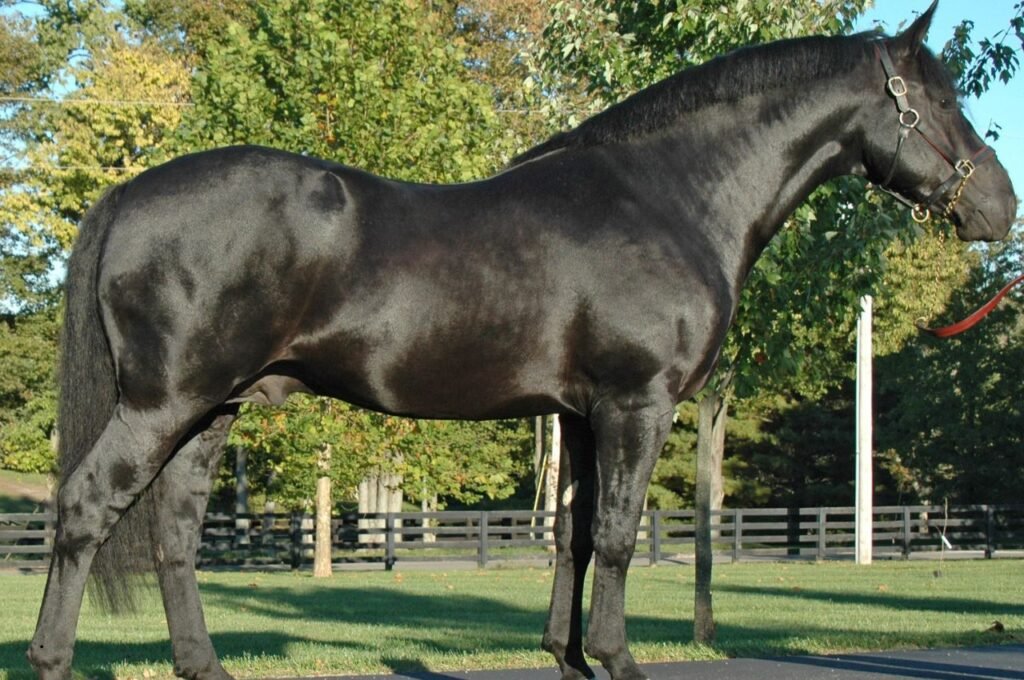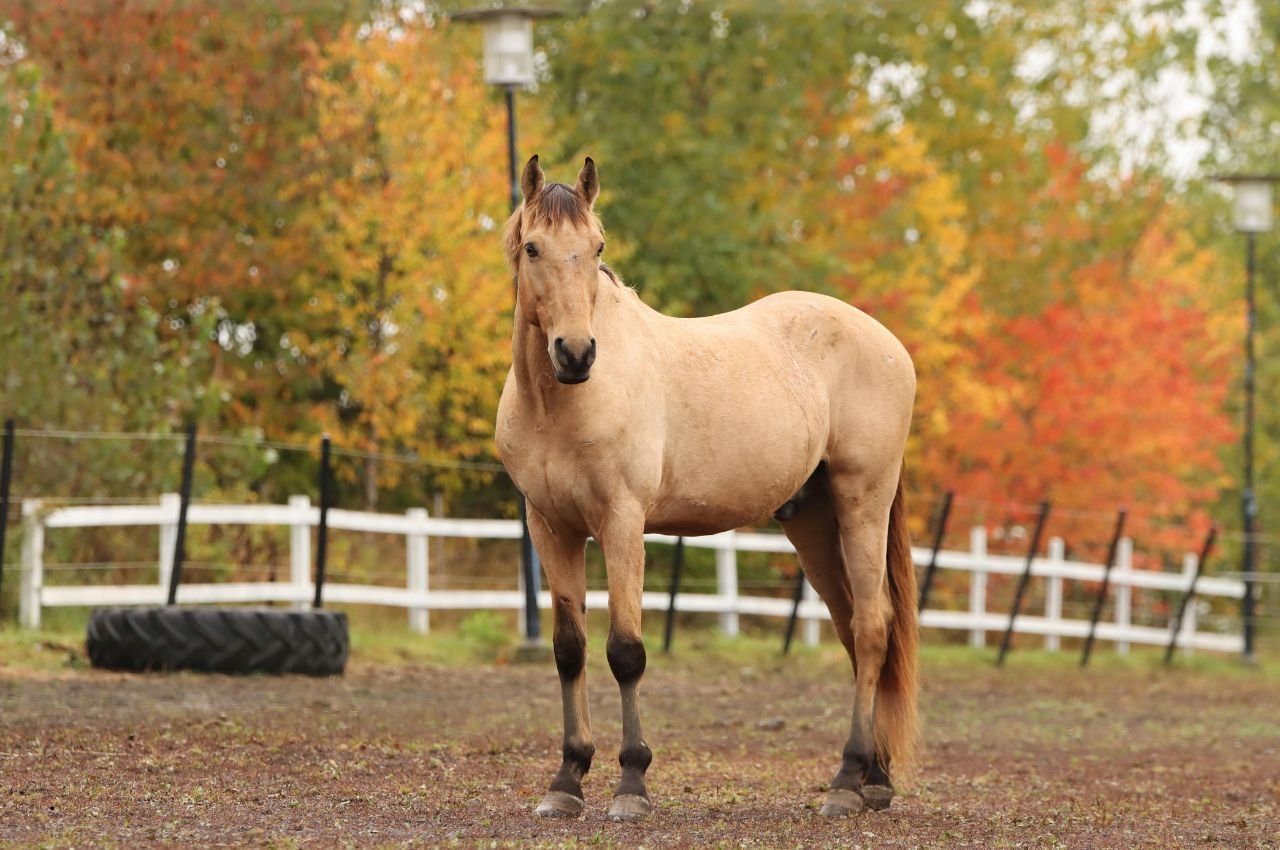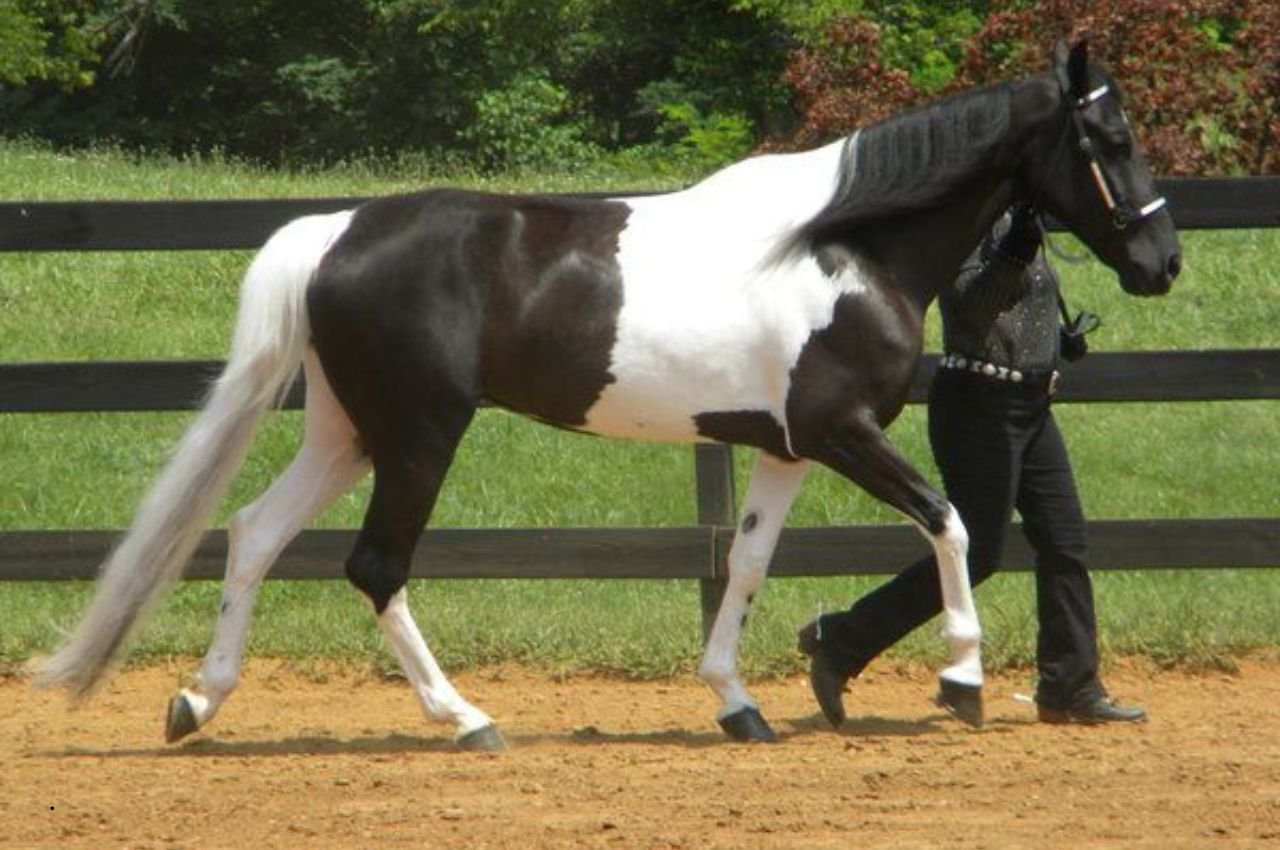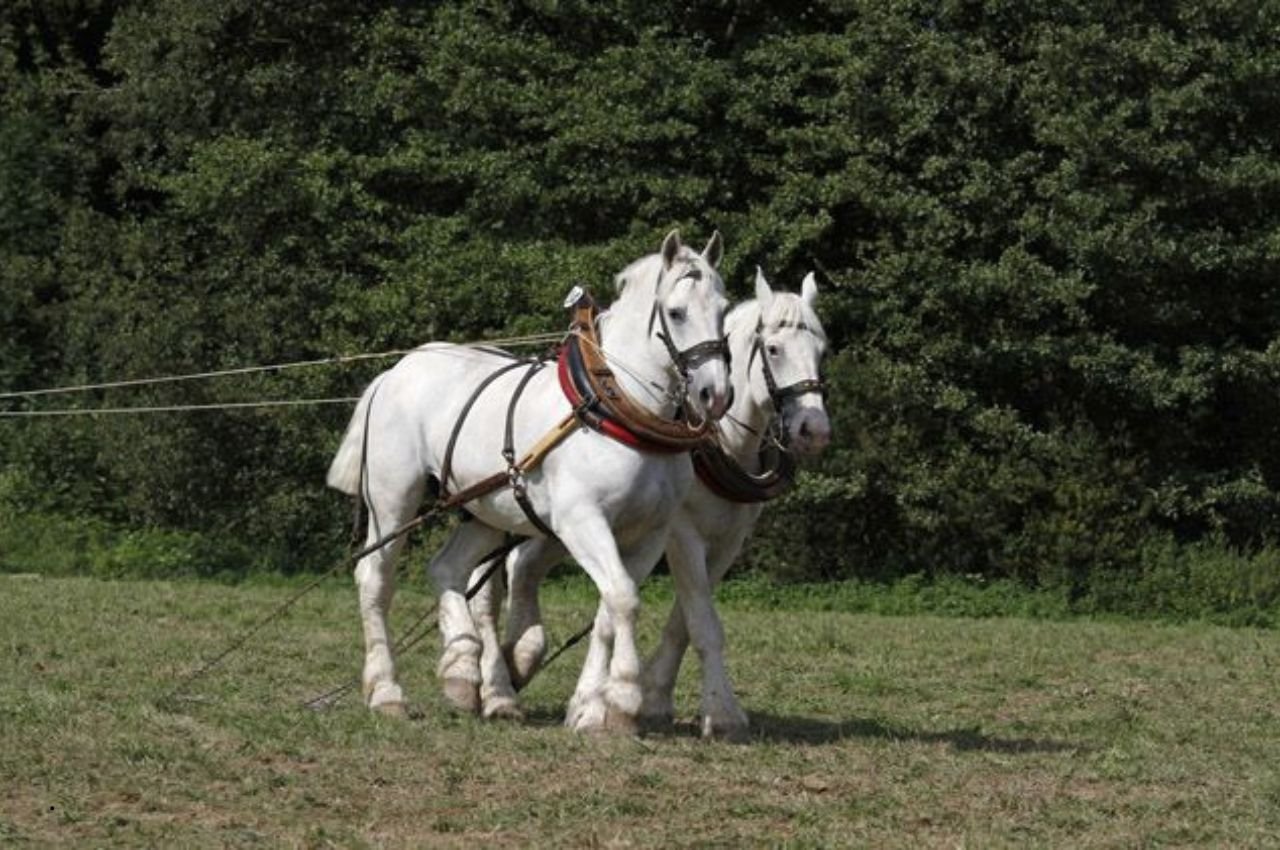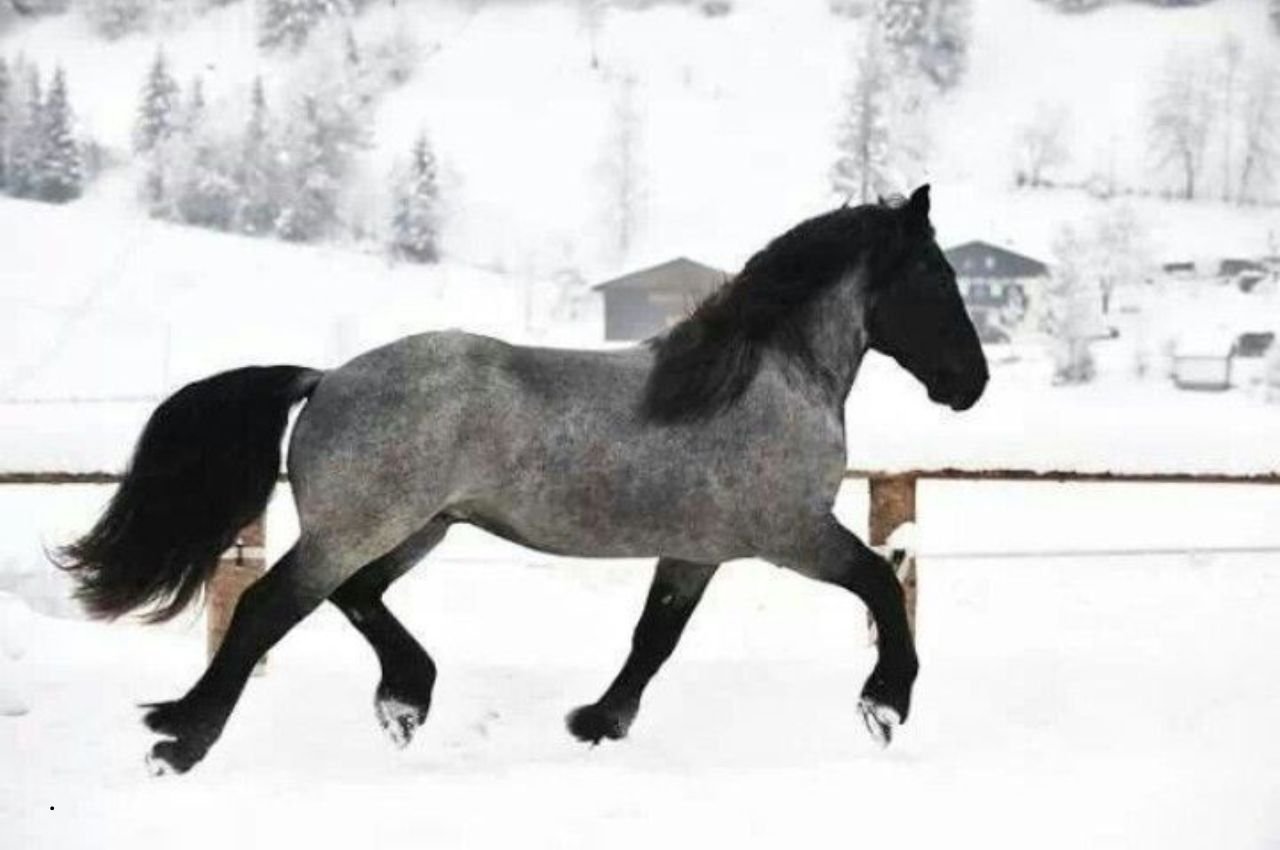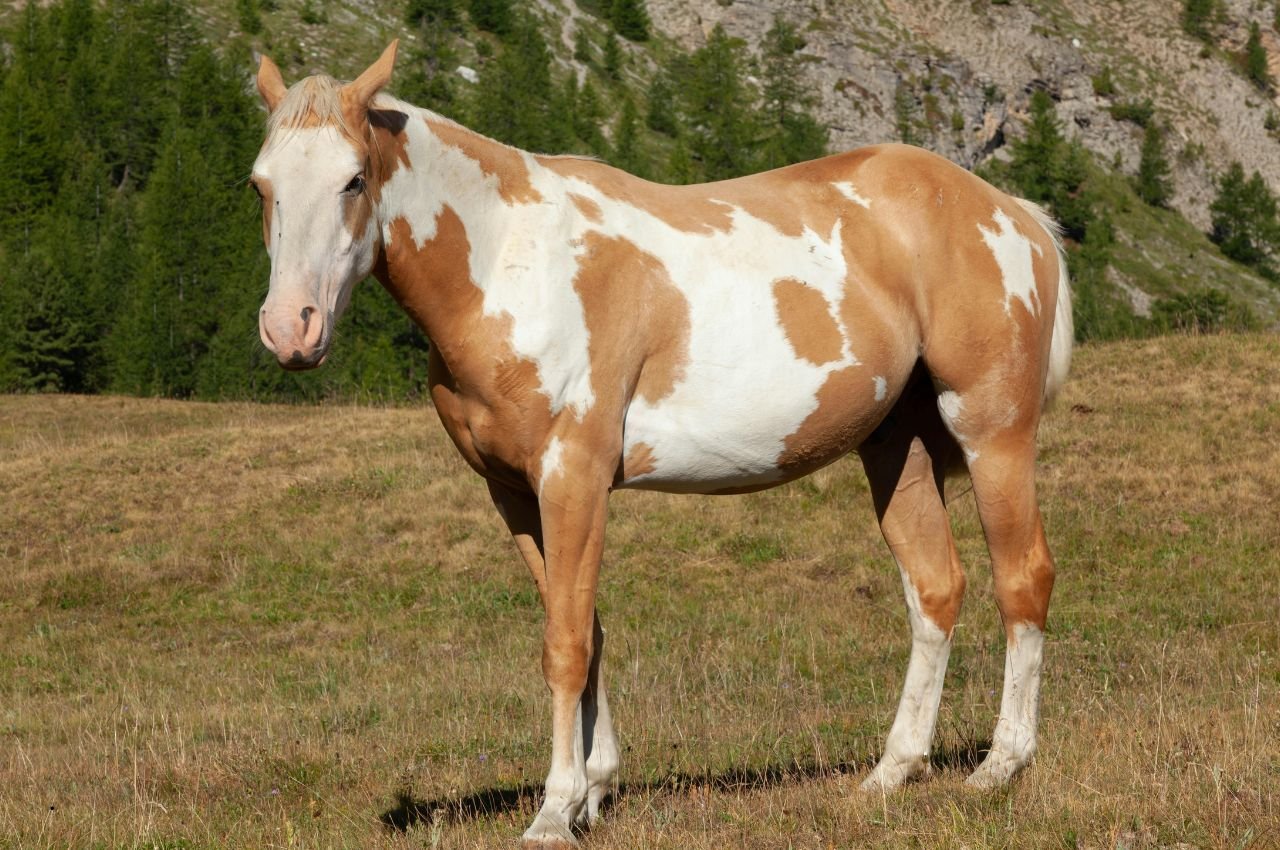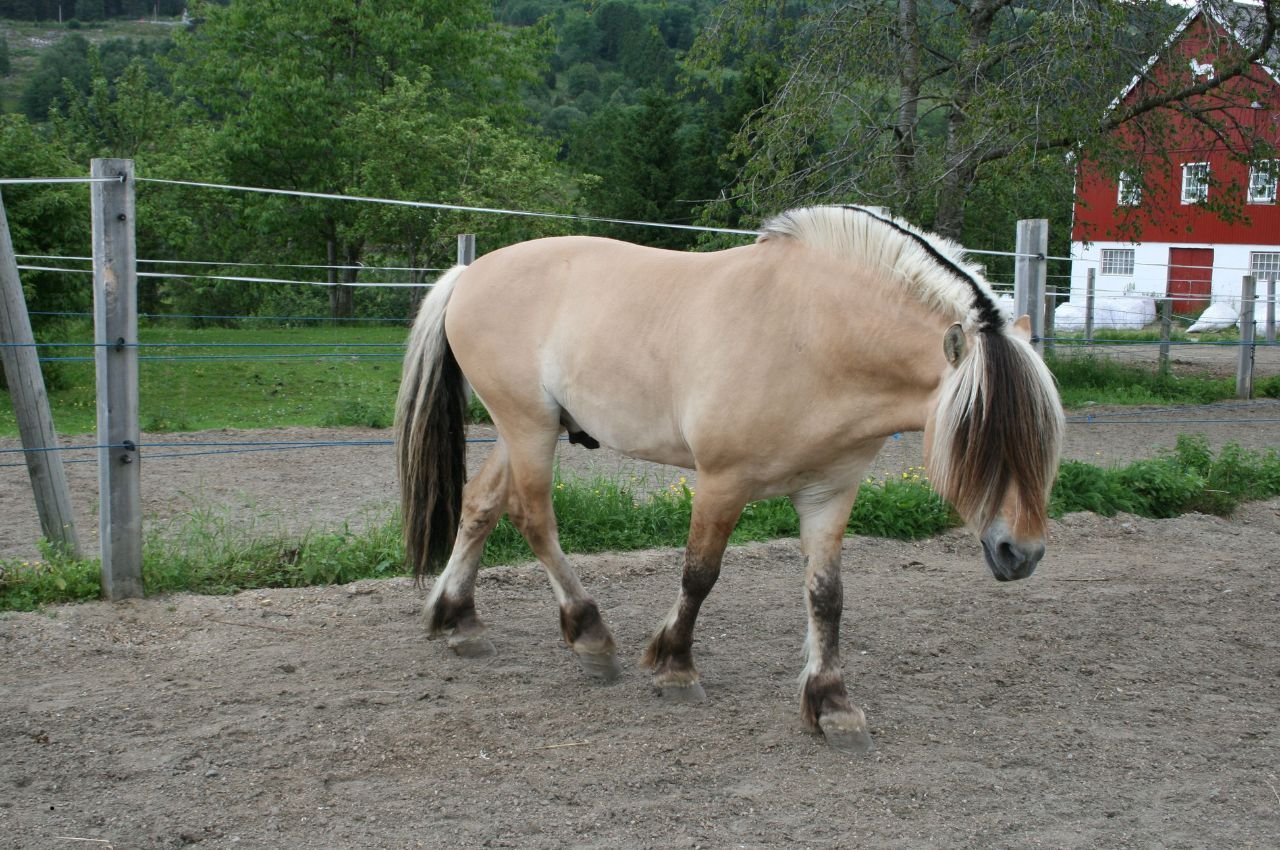The Irish Draught Horse stands as Ireland’s most treasured equine heritage, representing centuries of careful breeding that has produced one of the world’s most versatile and beloved warmblood breeds. The ideal Irish Draught displays a proud presence with substance and quality. These horses have generous but pleasant heads, expressive eyes, broad foreheads, and long ears. Far from being merely a heavy draft horse, Irish Draught horses are considered a warmblood breed. They are sound, sensible, and intelligent, are known for their extremely gentle dispositions, and are a great choice for novice riders.
What truly sets the Irish Draught apart from other European warmblood breeds is their remarkable combination of strength, athleticism, and temperament. Standing over a lot of ground, the Draught has an exceptionally strong and sound constitution, great stamina and an uncanny jumping ability. In addition, this breed possesses a fabulous temperament made up of willingness, intelligence, docility and common sense. Their legendary versatility has made them the foundation for countless sport horses while maintaining their value as both working horses and cherished family companions.
Historical Heritage and Development
The Irish Draught’s development spans centuries of Irish agricultural history, where pragmatic farmers created horses that could serve multiple roles with remarkable efficiency. The horse had to be docile, strong and economical to keep. Its traditional winter feed was young gorse put through a chaff-cutter, boiled turnips and bran or meal of some sort that could be spared from the cows. This economical approach to feeding shaped a breed renowned for its easy-keeping qualities and practical hardiness.
Early Origins and Agricultural Foundation
The Irish Draught emerged from the practical needs of Irish farmers who required horses capable of working the land during the day and carrying the family to town or church on Sundays. This dual-purpose breeding created horses with the strength for agricultural work combined with the refinement necessary for riding and driving applications.
There was also a need for Irish Draughts to be economical to keep, and this was achieved by grazing throughout the summer and supplementing their feed with chopped foraged gorse, boiled turnip and leftover cattle feed. This practical approach to nutrition created horses with exceptional metabolic efficiency and the ability to thrive on modest feed inputs.
The breed’s development was influenced by various European bloodlines, with Spanish, French, and later Thoroughbred influences contributing to their refinement and athletic ability. However, the core characteristics of strength, soundness, and tractability remained constant throughout their evolution.
Modern Breed Development and Recognition
The establishment of the Irish Draught Horse Society in 1917 marked the beginning of systematic breed improvement and registration. The society’s work ensured that breeding programs would maintain the qualities that made Irish Draughts valuable while allowing for continued refinement through careful genetic selection.
Gradually the breed developed into an animal around 15.2 h.h. – 16.2 h.h. in mares with stallions typically standing slightly taller. This size range provided the substance necessary for work while maintaining the agility and athletic ability that would make them famous as sport horse progenitors.
The 20th century brought both opportunities and challenges for the breed, with mechanization reducing demand for working horses while simultaneously creating new opportunities in sport horse breeding and recreational riding markets.
Physical Characteristics and Conformation
The Irish Draught presents a distinctive combination of substance and quality that reflects centuries of breeding for both work and athleticism. Lighter than its name implies, the Irish Draught Horse is smooth in its movement without an exaggerated gait. It has sound conformation, good stamina and quality jumping skills. This balance between power and refinement creates horses that excel in diverse applications.
Size and Overall Build
Irish Draught horses typically stand 15.2-17 hands high, with mares generally ranging from 15.2-16.2 hands and stallions from 16-17 hands. Their weight typically ranges from 1,300-1,600 pounds, placing them in the category of substantial warmbloods rather than heavy draft horses. This moderate size provides the strength necessary for work while maintaining the agility required for sport horse applications.
The breed’s conformation standards emphasize correctness and functionality over mere size or flashy appearance. Every aspect of their build serves the practical purpose of creating horses capable of sustained work while possessing the athletic ability necessary for jumping and sport applications.
Head and Neck Structure
These horses have generous but pleasant heads, expressive eyes, broad foreheads, and long ears. A slight Roman nose is acceptable. The neck is set high and connects to well-defined withers, and the chest is not too broad. This head type reflects both the breed’s working heritage and the refinement that makes them suitable for sport applications.
The intelligent expression and kind eye are hallmarks of the breed, reflecting the temperament that has made Irish Draughts beloved family horses for generations. The well-set neck provides the carriage necessary for athletic performance while maintaining the strength required for draft work.
Body and Limb Conformation
The Irish Draught’s body structure emphasizes functionality and soundness, with a deep chest that provides heart and lung capacity for sustained work, well-sprung ribs that support digestive efficiency, and a strong back that can carry weight comfortably. The breed’s movement quality reflects their balanced conformation.
Their movement is smooth, and their stride covers a lot of ground; they are versatile and a good choice for various equestrian disciplines. The legs show substantial bone with clean joints and well-formed hooves, reflecting breeding for soundness and longevity.
The breed typically displays minimal feathering on the lower legs, distinguishing them from heavier draft breeds while maintaining the clean appearance preferred in warmblood sports.
Color and Markings
Irish Draught horses appear in various colors including bay, chestnut, gray, and occasionally black. While white markings are acceptable, excessive white is generally discouraged in breeding programs. The breed’s color patterns reflect their diverse genetic background while maintaining consistency in type and temperament.
Temperament and Character
The Irish Draught’s temperament represents perhaps their greatest asset, combining the gentle nature necessary for family use with the intelligence and willingness required for athletic performance. The breed is also known for its calm temperament, willingness, intelligence and common sense. This exceptional character has made them beloved by riders of all levels and skill sets.
Mental and Emotional Characteristics
It’s known for its calm temperament and adaptability, making it a favourite for both work and leisure. The Irish Draught’s mental stability stems from centuries of breeding for horses that could work reliably in various situations while remaining safe and manageable for family use.
Their intelligence manifests in their ability to assess situations and respond appropriately, making them particularly valuable for novice riders who benefit from a horse with good judgment and forgiving nature. This cognitive ability also makes them excellent candidates for complex training programs.
Work Ethic and Cooperation
Their wonderful temperament makes them easy to work with in any discipline. The breed’s cooperative nature reflects generations of selection for horses willing to partner with humans in various activities, from farm work to sport competition.
Their work ethic is characterized by willingness rather than hot-blooded excitement, making them steady and reliable partners for long-term relationships. This quality has made them particularly valuable for amateur riders and therapeutic programs where consistency and safety are paramount.
Adaptability and Versatility
Their strength, intelligence and lightness of step means that they can perform in many varied disciplines including showjumping, eventing, dressage, hunting, showing, driving, Le Trec and endurance riding. This remarkable versatility reflects the breed’s balanced development and trainable nature.
Modern Irish Draught horses demonstrate exceptional adaptability to various roles, from traditional farm work to high-level sport competition, therapeutic riding, and family recreation. Their ability to excel across such diverse applications makes them uniquely valuable in today’s varied equine markets.
Versatility and Athletic Ability
The Irish Draught’s legendary versatility stems from their unique combination of physical attributes and mental characteristics that allow them to excel across an unprecedented range of disciplines. These horses are not just about strength; they also have a grace that makes them suitable for various equestrian activities. This versatility has made them the foundation for countless sport horses while maintaining their value in traditional roles.
Sport Horse Excellence
The Irish Draught’s reputation as a sport horse foundation reflects their exceptional jumping ability, athletic movement, and competitive temperament. Their natural jumping ability combines with their intelligence to create horses capable of competing at the highest levels of show jumping and eventing.
Cross-breeding programs with Thoroughbreds have produced the famous Irish Sport Horses that dominate international competition. However, purebred Irish Draughts continue to excel in their own right across multiple disciplines.
Their dressage capability reflects their natural balance and trainability, while their eventing success demonstrates their courage, stamina, and versatility across multiple phases of competition.
Working and Driving Applications
Traditional driving applications remain an important use for Irish Draught horses, where their strength, reliability, and good temperament make them excellent carriage horses and combined driving competitors.
Agricultural work continues to utilize Irish Draughts in sustainable farming operations where their efficiency and environmental sensitivity provide advantages over mechanical alternatives.
Forestry applications benefit from their sure-footedness and careful movement, making them valuable for selective logging operations where precision is essential.
Recreational and Educational Uses
Trail riding applications showcase the breed’s steady temperament and comfortable gaits, making them popular choices for recreational riding programs and riding vacations.
Educational programs utilize Irish Draughts for riding instruction where their forgiving nature and sensible temperament provide safe learning experiences for students of all ages and skill levels.
Therapeutic riding programs value their calm, steady temperament and smooth movement for working with participants who have special needs, while their intelligence allows them to adapt to varying program requirements.
Breeding and Genetics Applications
The Irish Draught’s role as a foundation breed for sport horse production continues to be their most economically significant application. Their genetic contribution to warmblood breeding programs worldwide has been immeasurable.
Outcrossing programs utilize Irish Draught genetics to add substance, temperament, and jumping ability to various sport horse populations. Their prepotency in passing on desirable traits makes them valuable breeding stock.
Health Considerations and Management
Irish Draught horses generally exhibit robust health and hardiness, but their breeding for athletic performance and their size create specific health management requirements. Understanding these considerations is essential for maintaining optimal health and performance throughout their careers.
General Health Strengths
The breed’s development under challenging Irish conditions has created horses with natural hardiness and strong constitutions. Their genetic diversity and outcrossing with various breeds has generally provided good hybrid vigor and disease resistance.
Irish Draughts typically enjoy good longevity when properly managed, often remaining sound and useful well into their twenties. Their efficient metabolism and hardy constitution contribute to overall wellness when appropriate management practices are followed.
Common Health Considerations
Like many warmblood breeds, Irish Draughts may be susceptible to certain orthopedic conditions related to their size and athletic use. Osteochondritis dissecans (OCD) can affect young horses, particularly in the stifle and hock joints.
Developmental orthopedic disease may occur in rapidly growing young horses, emphasizing the importance of proper nutrition and management during critical growth periods.
Some lines may show susceptibility to chronic progressive lymphedema, though this condition is less common in Irish Draughts than in some other draft-influenced breeds.
Preventive Health Care
Comprehensive preventive veterinary care should include regular health examinations, appropriate vaccination programs, consistent dental care, and systematic parasite management.
Reproductive health management becomes particularly important for breeding stock, with regular monitoring ensuring optimal fertility and successful breeding programs.
Regular joint health assessments help identify developing problems before they become performance-limiting, particularly important for horses intended for athletic careers.
Exercise and Conditioning
“Irish Sport Horses thrive when given a consistent program of preventive care and well-planned management. Regular farriery, dental checks, balanced nutrition, and tailored conditioning not only optimize performance but also safeguard soundness and long-term health.”
Conditioning programs should be tailored to the individual horse’s intended use while building fitness gradually to prevent injury. The breed’s willing nature requires careful monitoring to prevent overwork during training phases.
Farrier care takes on particular importance for athletic horses, as proper trimming and shoeing support performance while preventing lameness issues. Regular hoof care helps maintain soundness throughout their working careers.
Nutritional Requirements and Feeding Management
Irish Draught horses require carefully balanced nutrition programs that support their substantial size and potential athletic demands while preventing the problems associated with overfeeding. Like all horses, the Irish Draught horse needs a healthy balance of carbohydrates, proteins, minerals, vitamins and fresh water. Their heritage as easy keepers requires thoughtful feeding management.
Basic Nutritional Principles
They should be provided with a good mix of forage such as fresh grass, quality hay and grains if required. Irish Draught horses typically require 1.5-2.5% of their body weight in total feed daily, with the majority coming from quality forage sources.
For a typical Irish Draught weighing 1,400 pounds, daily feed requirements range from 21-35 pounds total, with at least 14-21 pounds coming from hay or pasture. Their efficient metabolism means they often require less feed per pound of body weight than more refined breeds.
Forage Quality and Management
High-quality hay forms the foundation of Irish Draught nutrition, with timothy hay, orchard grass, and mixed grass hays providing excellent base nutrition. Legume hays like alfalfa can be included but should be balanced with grass hays.
Pasture management becomes particularly important for Irish Draughts, whose efficiency as feed converters means they can easily become overweight on rich pastures. Rotational grazing and seasonal pasture restriction may be necessary.
The breed’s reputation for thriving on modest feed inputs makes them well-suited to pasture-based systems where they can utilize moderate-quality forage effectively.
Energy and Concentrate Requirements
Working or competing Irish Draughts may require additional energy from concentrate feeds, though their efficiency means feeding rates are often lower than expected. Grain feeds should be introduced gradually and divided into multiple daily meals.
Such a diet should be high in fibre and include super fibres, as well as oil, but bear in mind that the feed should be lower in cereals and therefore starch. This approach suits Irish Draughts well, as they often perform better on high-fiber, moderate-energy feeds.
Commercial feeds designed for warmbloods or moderate-energy formulations typically work well for most Irish Draughts. Their efficient metabolism may require individual assessment and adjustment of feeding rates.
Special Nutritional Considerations
Consistent access to clean, fresh water is essential to maintain adequate hydration in Irish Draught horses, with daily requirements typically ranging from 30-50 gallons depending on weather, work level, and diet composition.
Vitamin and mineral supplementation should be based on forage analysis and individual needs. Many Irish Draughts maintained on quality forage may require only basic salt supplementation and targeted mineral balancing.
Body condition monitoring becomes particularly important for easy-keeping breeds, requiring regular assessment and feeding adjustments to prevent obesity and related health problems.
Feeding for Different Life Stages and Uses
Growing Irish Draught horses require balanced nutrition that supports healthy development without promoting excessive growth rates that might predispose to developmental orthopedic disease. Weanling and yearling nutrition should emphasize quality over quantity.
Breeding mares require additional nutrition during late pregnancy and lactation, though their efficiency helps minimize additional feed requirements compared to other breeds.
Senior horse feeding may require dietary modifications for aging Irish Draughts, though the breed often maintains good health and body condition well into their twenties.
Competition horses may require performance nutrition programs tailored to their discipline and training intensity, though Irish Draughts often perform well on relatively conservative feeding programs.
Conservation Status and Breeding Challenges
The Irish Draught faces significant conservation challenges despite their popularity and versatility. Many Irish Draught mares never produce a purebred replacement for the herd. Aggressive selection for show jumping characteristics has degraded the foundation stock, and inbreeding to a few popular performance bloodlines has further endangered the genetic diversity of the breed. The Irish Draught is considered an “endangered maintained” breed by the Food and Agriculture Committee of the United Nations.
Current Conservation Status
In 2024, the breed was listed as “threatened” on The Livestock Conservancy’s Conservation Priority List. This status reflects the ongoing challenges facing purebred Irish Draught populations worldwide, despite the breed’s success in sport horse production.
The primary threat to the breed comes from their own success as sport horse producers. The popularity of the resulting cross as a recreational riding horse led to the decline of purebred Irish Draughts as breeders focused on producing crossbred horses rather than maintaining purebred populations.
Breeding Challenges and Solutions
Aggressive selection for show jumping characteristics has degraded the foundation stock, and inbreeding to a few popular performance bloodlines has further endangered the genetic diversity of the breed. This concentration on performance bloodlines has reduced the genetic base available for breed preservation.
Modern conservation breeding programs work to maintain genetic diversity while preserving the characteristics that make Irish Draughts valuable. Genetic testing helps identify relationships and prevent inbreeding in small populations.
International cooperation between breed organizations helps maintain genetic diversity by facilitating breeding exchanges between geographically separated populations.
Conservation Efforts and Support
The Irish Draught Horse Society of Ireland, with support from the Royal Dublin Society leads conservation efforts through breeding programs, education, and promotion of purebred Irish Draughts.
Breed preservation initiatives include:
- Maintaining studbooks and pedigree records
- Supporting breeding programs that emphasize breed type
- Educating breeders about conservation needs
- Promoting purebred Irish Draughts in appropriate disciplines
Economic incentives for maintaining purebred Irish Draughts include their value as breeding stock, their versatility for multiple uses, and their appeal to riders seeking horses with proven temperaments and abilities.
Training and Development
Irish Draught horses respond exceptionally well to systematic training programs that take advantage of their intelligence, willingness, and athletic ability. Their tractable temperament makes them suitable for riders and trainers of varying experience levels while their versatility allows for diverse training approaches.
Foundation Training Principles
Ground training forms the essential foundation for Irish Draught development, taking advantage of their intelligent, cooperative nature. Their size and strength require clear communication and respect from the beginning, though their gentle temperament makes basic training generally straightforward.
Basic handling skills including leading, tying, grooming, and basic manners must be thoroughly established. The breed’s intelligence typically makes this foundation training efficient and rewarding for both horse and handler.
Young horse development should progress systematically, taking advantage of their willing nature while ensuring proper physical and mental development. Their versatility means early training can explore various disciplines to identify individual strengths and preferences.
Riding and Performance Training
Under-saddle training for Irish Draughts typically progresses smoothly due to their balanced temperament and natural athletic ability. Their movement quality and jumping ability often become apparent early in training.
Jumping training takes advantage of their natural ability while developing the technical skills necessary for competition. Their intelligence and carefulness make them excellent students for complex jumping exercises.
Dressage training develops their natural balance and movement while taking advantage of their trainability and work ethic. Many Irish Draughts excel in dressage despite not being specifically bred for the discipline.
Driving and Harness Training
Driving training remains an important application for Irish Draughts, taking advantage of their strength, reliability, and steady temperament. Harness training typically progresses smoothly with their cooperative nature.
Combined driving training develops their athletic ability across multiple phases while showcasing their versatility and intelligence. Their natural balance and carefulness serve them well in driven dressage, marathon, and cones phases.
Specialized Training Applications
Therapeutic riding training prepares Irish Draughts for work with special needs riders, taking advantage of their calm, steady temperament and smooth movement.
Educational program training develops their role as ambassadors for the breed while teaching various skills that showcase their versatility and intelligence.
Modern Applications and Uses
Contemporary Irish Draught horses serve in diverse roles that showcase their legendary versatility while contributing to breed preservation through demonstrating their continued relevance and value. Their adaptability has allowed them to transition successfully from traditional farm work to modern equestrian sports and specialized applications.
Sport Horse Production and Competition
The Irish Draught’s most economically significant modern role remains as foundation stock for sport horse breeding. Their genetic contribution to international sport horse populations continues to be immeasurable, with Irish-bred horses dominating many international competitions.
Crossbreeding programs utilize Irish Draught genetics to add substance, jumping ability, and temperament to various warmblood populations. The resulting Irish Sport Horses compete successfully at the highest levels of show jumping, eventing, and dressage.
Purebred Irish Draughts continue to compete successfully in appropriate divisions, demonstrating that the original breed remains competitive in modern sport. Their success helps maintain interest in purebred breeding programs.
Recreational and Amateur Applications
Amateur sport horse applications represent a growing market where Irish Draughts excel due to their forgiving temperament and natural ability. Their intelligence and careful nature make them ideal partners for adult amateur riders.
Pleasure driving remains a popular use for Irish Draughts, where their impressive appearance and steady temperament make them excellent carriage horses for both competition and recreational driving.
Trail riding and recreational riding programs value their steady temperament, sure-footedness, and comfortable movement for riders seeking reliable, enjoyable mounts.
Educational and Therapeutic Uses
Riding instruction programs utilize Irish Draughts for their safe, forgiving temperament and natural balance. Their intelligence allows them to adapt to riders of varying skill levels while maintaining safety.
Therapeutic riding programs benefit from their calm, steady movement and gentle temperament, making them valuable partners for participants with various disabilities or special needs.
University equine programs use Irish Draughts to teach various aspects of horse management, training, and breeding while providing students with hands-on experience with versatile, intelligent horses.
Sustainable Agriculture and Land Management
Sustainable farming operations increasingly recognize the benefits of Irish Draught horses for specialized applications where their power, intelligence, and environmental sensitivity provide advantages over mechanical alternatives.
Organic farming systems value their ability to provide cultivation power without soil compaction or chemical inputs, while their efficiency helps reduce operational costs.
Conservation grazing programs utilize their selective feeding habits and careful movement to manage sensitive ecosystems and maintain biodiversity in various habitat management projects.
Cultural and Heritage Preservation
Cultural preservation programs showcase the Irish Draught’s role in Irish agricultural history while maintaining traditional skills and knowledge about working with horses.
Living history programs utilize Irish Draughts to demonstrate traditional Irish farming methods and rural life, helping preserve cultural knowledge for future generations.
Breed promotion activities help maintain public awareness and support for Irish Draught conservation while showcasing their continued relevance in modern applications.
Frequently Asked Questions (FAQs)
General Breed Information
Q: What makes Irish Draught horses different from other warmblood breeds? A: Lighter than its name implies, the Irish Draught Horse is smooth in its movement without an exaggerated gait. It has sound conformation, good stamina and quality jumping skills. Unlike other warmbloods, they were bred specifically for versatility, combining working ability with sport horse attributes and exceptional temperament.
Q: Are Irish Draught horses actually draft horses? A: Irish Draught horses are considered a warmblood breed rather than true draft horses. While they have substance and strength, they are lighter and more athletic than traditional heavy draft breeds, developed for versatility rather than pure pulling power.
Q: What size are Irish Draught horses? A: Irish Draught horses typically stand 15.2-17 hands high, with mares ranging 15.2-16.2 hands and stallions 16-17 hands. They weigh 1,300-1,600 pounds, placing them in the substantial warmblood category rather than heavy draft.
Q: What is the temperament of Irish Draught horses? A: This breed possesses a fabulous temperament made up of willingness, intelligence, docility and common sense. They are sound, sensible, and intelligent, are known for their extremely gentle dispositions, and are a great choice for novice riders.
Versatility and Uses
Q: What disciplines can Irish Draught horses perform? A: Their strength, intelligence and lightness of step means that they can perform in many varied disciplines including showjumping, eventing, dressage, hunting, showing, driving, Le Trec and endurance riding. They are one of the most versatile breeds available.
Q: Are Irish Draught horses good for beginners? A: They are sound, sensible, and intelligent, are known for their extremely gentle dispositions, and are a great choice for novice riders. Their forgiving temperament and natural balance make them excellent for learning riders.
Q: Can Irish Draught horses jump well? A: Yes, standing over a lot of ground, the Draught has an exceptionally strong and sound constitution, great stamina and an uncanny jumping ability. They are renowned for their natural jumping talent and form the foundation of many successful sport horses.
Q: Are Irish Draught horses good for driving? A: Absolutely! Their strength, steady temperament, and intelligence make them excellent driving horses for both recreational and competitive applications. They excel in combined driving and carriage work.
Q: What makes Irish Sport Horses so successful? A: Irish Sport Horses are crosses between Irish Draughts and Thoroughbreds, combining the Irish Draught’s jumping ability, temperament, and substance with Thoroughbred speed and athleticism. This combination has proven extremely successful in international sport.
Care and Management
Q: Are Irish Draught horses easy keepers? A: Yes, the horse had to be docile, strong and economical to keep. There was also a need for Irish Draughts to be economical to keep, and this was achieved by grazing throughout the summer and supplementing their feed with simple, local feeds. They are known for thriving on modest feed inputs.
Q: What housing do Irish Draught horses need? A: Irish Draughts adapt well to various housing systems from simple shelters to elaborate barns. They typically need stalls of at least 12′ x 12′ with larger sizes being preferable. Their hardy nature means they require less intensive shelter than some breeds.
Q: How much exercise do Irish Draught horses need? A: Their exercise needs vary based on their intended use, but they benefit from regular turnout and consistent activity. Working horses need systematic conditioning programs, while pleasure horses do well with regular riding or driving.
Q: What type of fencing is suitable for Irish Draught horses? A: Sturdy fencing systems like board fencing or post and rail work well. Their generally calm temperament means they respect boundaries well, though fencing must be strong enough for their size and substance.
Health and Nutrition
Q: What health issues are common in Irish Draught horses? A: They’re generally healthy but may be susceptible to osteochondritis dissecans (OCD) and developmental orthopedic disease in young horses. Some lines may show chronic progressive lymphedema, though this is less common than in heavier breeds.
Q: How much do Irish Draught horses eat? A: They should be provided with a good mix of forage such as fresh grass, quality hay and grains if required. They typically need 1.5-2.5% of body weight in feed daily, with most coming from quality forage. Their efficiency means they often need less feed than expected.
Q: What type of diet works best for Irish Draught horses? A: Such a diet should be high in fibre and include super fibres, as well as oil, but bear in mind that the feed should be lower in cereals and therefore starch. They perform well on high-fiber, moderate-energy diets rather than high-starch feeds.
Q: Do Irish Draught horses need supplements? A: Like all horses, the Irish Draught horse needs a healthy balance of carbohydrates, proteins, minerals, vitamins and fresh water. Many do well with basic mineral supplementation and salt, with additional supplements based on individual needs.
Q: How long do Irish Draught horses typically live? A: Irish Draughts typically enjoy good longevity, often remaining sound and useful well into their twenties. Their hardy constitution and efficient metabolism contribute to excellent lifespan when properly managed.
Breeding and Conservation
Q: Why are Irish Draught horses considered endangered? A: The Irish Draught is considered an “endangered maintained” breed by the Food and Agriculture Committee of the United Nations. Many Irish Draught mares never produce a purebred replacement for the herd, as breeders focus on producing Irish Sport Horse crosses instead.
Q: What threatens the Irish Draught breed? A: Aggressive selection for show jumping characteristics has degraded the foundation stock, and inbreeding to a few popular performance bloodlines has further endangered the genetic diversity of the breed. The popularity of crosses has reduced purebred breeding.
Q: Where can I find Irish Draught horses? A: Contact the Irish Draught Horse Society for breeder information. They’re most common in Ireland and the UK, with smaller populations in North America and other countries. Breed registries maintain breeder directories.
Q: Are Irish Draught horses expensive? A: Pricing varies widely based on age, training, bloodlines, and intended use. Quality breeding stock and trained horses typically command premium prices, while their versatility and proven abilities support good market values.
Q: Can I register Irish Draught crosses? A: Irish Sport Horses (crosses with Thoroughbreds) have their own registry, but these crosses cannot be registered as purebred Irish Draughts. Only horses with documented Irish Draught parentage on both sides qualify for purebred registration.
Training and Performance
Q: Are Irish Draught horses easy to train? A: Yes, their wonderful temperament makes them easy to work with in any discipline. Their intelligence, willingness, and steady temperament make them excellent training subjects for various applications.
Q: At what age can Irish Draught horses start training? A: Like other horses, basic ground training can begin as foals, with more serious training typically starting around 3-4 years old. Their sensible temperament often makes them mature earlier mentally than some breeds.
Q: Can Irish Draught horses compete at high levels? A: While purebreds can compete successfully in appropriate divisions, their greatest success comes through their genetic contribution to sport horse breeding. Irish-bred horses dominate many international competitions.
Q: What makes Irish Draught horses good for amateur riders? A: Their combination of athletic ability, forgiving temperament, and intelligence makes them ideal for amateur riders who want competitive horses that are safe and enjoyable to work with.
Care and Management Requirements
Successful management of Irish Draught horses requires understanding their heritage as versatile, hardy horses while providing appropriate care for their substantial size and athletic potential. Their reputation as easy keepers makes them economical to maintain while requiring thoughtful management to prevent problems associated with overfeeding.
Housing and Shelter Systems
Irish Draught horses adapt well to various housing systems, reflecting their heritage as hardy, practical horses. Simple run-in shelters often suffice for their basic needs, though horses in training or breeding programs benefit from more elaborate barn facilities.
Stall requirements should accommodate their substantial warmblood size, typically needing stalls of 12′ x 12′ minimum with larger dimensions preferred for comfort. Barn design considerations include adequate ceiling height, appropriate ventilation, and door dimensions suitable for their size.
The breed’s generally calm temperament and social nature make them well-suited to group housing systems where space and management allow. Their intelligence and adaptability help them adjust to various housing arrangements.
Pasture Management and Land Use
Pasture requirements typically range from 1-2 acres per horse for adequate forage, though Irish Draughts’ efficiency as feed converters means they can often maintain condition on less land than other horses of similar size.
Rotational grazing systems work particularly well with Irish Draughts, as their careful movement and selective grazing habits help maintain pasture quality while maximizing forage utilization.
Pasture restriction may be necessary during lush growing periods, as their easy-keeping nature can lead to obesity on rich grass. Track systems and restricted grazing help manage intake while providing exercise.
Daily Care and Grooming
Irish Draught horses require standard equine grooming routines adapted for their size and coat characteristics. Their minimal feathering makes leg care straightforward compared to heavily feathered breeds.
Regular hoof care becomes particularly important for horses intended for athletic use, with proper trimming and shoeing supporting performance while preventing lameness. Professional farrier services experienced with sport horses are beneficial.
Their generally good coat quality responds well to regular grooming programs that maintain cleanliness while promoting circulation and bonding between horse and handler.
Exercise and Fitness Management
Irish Draught horses benefit from regular exercise programs that maintain their fitness and mental well-being. Horses not in active work should receive adequate turnout and movement opportunities.
Conditioning programs for horses intended for athletic careers should be systematic and progressive, taking advantage of their natural fitness while building sport-specific conditioning gradually.
Their versatility allows for varied exercise routines that prevent boredom while developing different aspects of their fitness and training.
Conclusion
The Irish Draught Horse stands as a testament to centuries of thoughtful breeding that created one of the world’s most versatile and beloved equine breeds. Their unique combination of strength, athleticism, intelligence, and gentle temperament has made them invaluable partners across an unprecedented range of applications, from traditional farm work to international sport horse competition.
The breed’s legendary versatility – their strength, intelligence and lightness of step means that they can perform in many varied disciplines including showjumping, eventing, dressage, hunting, showing, driving, Le Trec and endurance riding – reflects the practical wisdom of Irish farmers who created horses capable of serving multiple roles efficiently and reliably.
However, the Irish Draught’s greatest challenge today comes from their own success. The popularity of Irish Sport Horse crosses has inadvertently threatened the purebred population, with many Irish Draught mares never produce a purebred replacement for the herd. This conservation crisis requires immediate attention from breeders, breed organizations, and equine enthusiasts worldwide.
For those considering Irish Draught horses, whether for sport horse breeding, amateur competition, recreational riding, or conservation breeding, these remarkable horses offer a unique combination of proven performance, exceptional temperament, and genetic value that few breeds can match.
The future of the Irish Draught depends on recognizing their value as purebred horses while supporting conservation efforts that maintain genetic diversity and breed characteristics. Their continued success as foundation stock for sport horse production demonstrates their genetic worth, but this success must be balanced with maintaining viable purebred populations.
As interest in versatile horses, sustainable agriculture, and amateur-friendly sport horses continues to grow, the Irish Draught is positioned to remain valuable and relevant for future generations, provided that conservation efforts receive adequate support and dedication.
With proper care, nutrition, and management, Irish Draught horses can serve as both exceptional riding and driving horses and valuable breeding stock, embodying the perfect balance of substance, athleticism, and temperament that has made them Ireland’s greatest equine gift to the world.
References and Resources
For comprehensive breed information and conservation status, the Irish Draught Horse Society provides detailed information about breed standards, breeding programs, and registration requirements for purebred Irish Draughts.
Official breed standards and historical information can be found through Oklahoma State University – Irish Draught Horses, offering academic perspectives on breed development and characteristics.
Contemporary breed profiles and management information are available at Mad Barn – Irish Draught Horse Breed Profile, providing practical guidance for modern horse owners and breeders.
Sport horse breeding information and Irish Sport Horse development can be found through Irish Sport Horse breeding organizations that promote and regulate crossbreeding programs.
Conservation efforts and endangered breed status are documented by The Livestock Conservancy and other conservation organizations working to preserve rare and endangered horse breeds worldwide.
Scientific research and genetic information are available through equine genetics laboratories that provide testing services and research into breed diversity and health.
Professional feeding and nutrition guidance specific to warmblood breeds can be found through equine nutrition specialists who provide research-based recommendations for optimal health and performance.
Training and management resources for versatile horses are available through riding organizations and driving associations that promote various equestrian disciplines.
Veterinary information specific to Irish Draught health considerations can be found through equine veterinary resources and sport horse health organizations that focus on athletic horse wellness.
This comprehensive guide provides general information about the Irish Draught Horse breed. Always consult with qualified veterinarians, equine nutritionists, breed societies, and experienced horsemen for specific advice regarding individual horses, breeding decisions, conservation efforts, and management programs.

